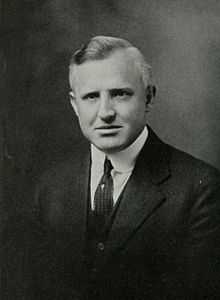Franklin S. Harris
| Franklin S. Harris | |
|---|---|
 Harris pictured in The Banyan 1923, BYU yearbook | |
| President of Brigham Young University | |
| Term | 1921 – 1945 |
| Predecessor | George H. Brimhall |
| Successor | Howard S. McDonald |
| Born |
August 29, 1884 Benjamin, Utah |
| Died |
April 18, 1960 (aged 75) Salt Lake City, Utah |
Franklin Stewart Harris (August 29, 1884 – April 18, 1960) was president of Brigham Young University (BYU) from 1921 until 1945, and president of Utah State University from 1945 to 1950.
His administration was the longest in BYU history and saw the granting of the first master's degrees. Under his administration the school moved towards being a full university. He set up several colleges, such as the College of Fine and Performing Arts with Gerrit De Jong as the founding dean.
Harris was an agricultural scientist. He received his doctorate from Cornell University.[1] He had served as the agriculture department head and head of the experiment station at Utah State Agricultural College and left BYU to become president of that institution.
The Harris Fine Arts Center on BYU's Provo campus is named after him.
Early life
Harris was born in Benjamin, Utah Territory, United States.[2] In the 1890s his family moved to the Mormon colonies in the Mexican state of Chihuahua. Harris did his early studies at BYU before going on to receive his doctorate from Cornell.
BYU presidency
One of Harris's first announcements on coming to campus was a need to make BYU a center of religious scholarship and a desire to have a broad spectrum of religious books in the library.[3] The first building built on BYU campus during Harris's administration was the Heber J. Grant building which at that point was a library. This was the first BYU building built as a library, but it soon became too small to hold all the books Harris had managed to have the University acquire.
In 1945 Harris left BYU to assume the presidency of Utah State Agricultural College.
Politics
In 1938 Harris was the Republican candidate for United States Senate in Utah. He lost to Democrat Elbert Thomas.[4]
Other church service
In 1923 Harris was made a member of the General Board of the Young Men's Mutual Improvement Association.[2]
In 1926 he served as a missionary in Japan. He also served a short mission among the Latter-day Saints in Syria in 1927.[2]
International work
In 1929 Harris was involved with founding a Jewish colony in Siberia.
In the early 1950s Harris worked in Iran, where he served as the president of the LDS Church branch headquartered in Tehran, as reported in the October 1951 general conference. He died in 1960.[2]
References
- ↑ Winters, Charlene (Fall 1998). "Franklin S. Harris". BYU Magazine. Retrieved 2009-12-10.
- ↑ 2.0 2.1 2.2 2.3 Jenson, Andrew. "HARRIS, Franklin Stewart," Latter-day Saint Biographical Encyclopedia (Salt Lake City, Utah: Deseret News Press, 1936) Vol 4, p. 240
- ↑ Bergera, Gary James; Ronald Priddis (1985). Brigham Young University: A House of Faith. Signature Books.
- ↑ Wilkinson, Ernest L., BYU: The First 100 Years (Provo: BYU Press, 1975) Vol. 2, p. 240
External links
| Academic offices | ||
|---|---|---|
| Preceded by George H. Brimhall |
President of BYU 1921–1945 |
Succeeded by Howard S. McDonald |
| Preceded by Elmer George Peterson |
President of Utah State University 1945–1950 |
Succeeded by Louis Linden Madsen |
|